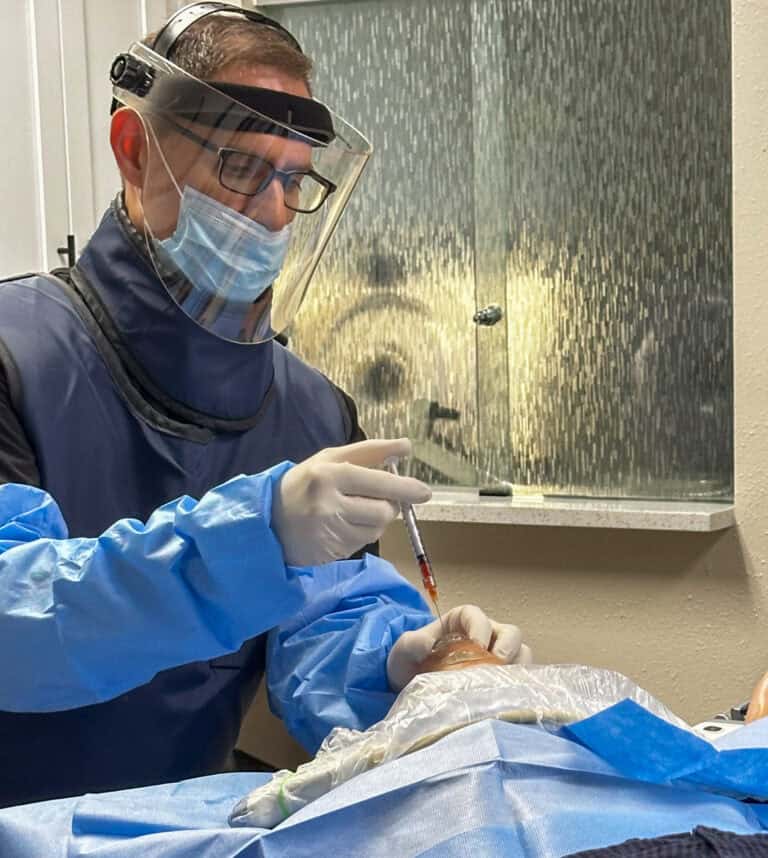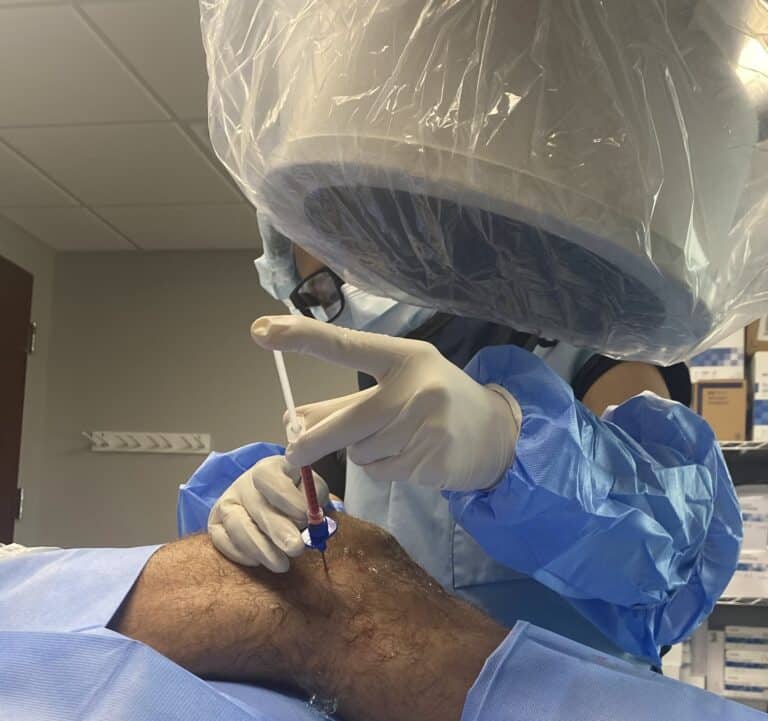New Data
Hot off the press is new data in support of interosseous (in-the-bone) injections for patients deemed candidates for knee replacements. The two studies both have significant data in favor of the efficacy of Intraosseous procedures as compared to intraarticular injections and total knee replacements.
We will get into those details, but first let’s take a look at our current understanding of the track record Regenexx has on patients reporting knee pain, and also gain an understanding of the research process.
Overview – Knee Success/Registry Data
Knees are one of the most commonly treated joins in the Regenexx registry network. There are more than 12,700 knee procedures that have been tracked for progress or side-effects post-procedure. Of these cases, the patients answer questions to report their sense of perceived progress as it relates to function, pain reduction, and overall improvement. The Regenexx Patient Results data illustrates “patients feel their joints are, on average, already 37% better after only 1-month” (1).
Why is this Regenexx Registry data significant? Within the Regenexx network, there are thorough processes and standardization of physician training, advanced proprietary lab processing techniques, and procedures with image guidance.
Regenexx clinicians are held to these standards for procedures, as compared to “stem cell therapy” clinics, which may use products from birth tissue, umbilical cords, or other exogenous sources. Also, other clinicians in the regenerative medicine field who aren’t Regenexx-trained often perform “blind” injections, meaning that they do not use image guidance when performing the injections.
These discrepancies in how regenerative procedures are performed have a profound effect on the outcomes of the procedure. So, if a person has had a procedure that was deemed successful or unsuccessful, knowing the details of how the provider was trained, how the blood or bone marrow product was acquired and processed, and/or how the procedure was performed makes a significant difference.
Research Matters
Regenexx also is committed to always staying on top of the most current research in the field of regenerative medicine. When new data or information is revealed by published and peer-reviewed research, Regenexx assimilates this information into their current standards and processes. What makes a study valid and able to change the status quo in medicine, is the gold standard called a randomized controlled trial, or RCT.
In an RCT, the therapy in question or a new therapeutic concept is randomly compared against a control, which could be a placebo or a more traditional treatment style.
As it relates to the research and outcomes for Regenexx knee procedures, Chris Centeno, MD of the Centeno Schultz Clinic states: “Up until recently, the only technology to date that had a reasonably powered randomized controlled trial that demonstrated long-term positive results in treating knee arthritis was injecting your own bone marrow concentrate into the knee joint. That was [a Regenexx] study performed using the standardized Regenexx technique. However, that changed with two new studies focused more on injecting the bone than the joint.”
Hernigou Studies Overview
Philippe Hernigou is a French physician and researcher, who initially published studies in the treatment of avascular necrosis of the hip. In these studies, he explored the improvement of these conditions with injection procedures directly into the bone. Hernigou then sought to study injecting the bone, or injecting directly into the subchondral space, in cases of advanced knee arthritis. Hernigou has published two studies looking specifically at the long-term results of injecting directly into the bone, as compared to intra articular injections and even compared to total knee replacements (TKR). The patients in both studies were then tracked for a long period- 15 years – to assess which therapeutic intervention had the most lasting effect.
The first study compared the lasting effects of Interosseous (IO), or in-the-bone injections versus TKR and the second study compared the last effects of Interosseus versus intra articular (IA) or in-joint only procedures, using bone marrow concentrate (BMC). The procedures and findings of the 15-year studies were as follows.
Study 1 – Interosseous/In-the-Bone (IO) versus TKR
There were 140 study participants deemed as candidates for a TKR on both knees due to medial knee arthritis. These patients were randomized to have both knees treated, but one being with IO injections and one being with a TKR surgery. The knees chosen for each were at random per patient (6,8).
After an average of 15 years, the number of patients who had converted to TKR on the IO-treated knee were After an average of 15 years, the number of patients who had converted to TKR on the IO-treated knee were tracked, as well as how many TKR knees needed revision surgeries. Of the 140 patients studied, only 18% converted to a TKR on the IO-treated knee. But, “[s]urprisingly, the number of knee replacement knees that needed second knee replacement surgeries (revisions) was almost as high as the number of IO knees that converted to knee replacement” (8).
Study 2 – Interosseous/in-the-Bone (IO) versus Intraarticular (IA)/In-Joint Only
This study included 60 participants and was performed between years 2000 and 2005 (7,8). The patients treated in these years were randomly treated on one side with either an IO or IA procedure. These patients were then tracked for 15 years. Within the 15 years, 5% of patient treated with the IA resorted to TKR Knee surgery, while just 1% of these with the IO procedure resorted to a TKR. At the end of the 15 years 70% of those with IA procedures needed TKR, while only 20% of patients needed TKR in the IO treatment group.
This data is compelling and in favor of the long-term benefits of IO treatments if a patient is trying to avoid or delay a total knee replacement.
New Standard?
The data from these studies is exciting in the world of regenerative medicine! Our physicians at Regenexx Tampa Bay at New Regeneration Orthopedics of Florida have used IO procedures in patients for years, and for various injuries. However, this new data has updated our standard processes to offer any patient who is a TKR candidate and IO procedure for their knee. The data comes from physicians using high concentrations of growth factors in the bone marrow concentrate that Regenexx clinics like us have the specialized processing methods to achieve.
A frequently-asked question for us is if this type of procedure is painful since the injection is performed by injecting inside of the bone? Actually, our patients are kept comfortable by numbing the skin, the deep tissues surrounding the treatment area, and nerve blocks when necessary. Additionally, we utilize very fine needles to perform the procedure. Most patients tolerate this very well. The recovery includes soreness and recovery down-time, so we refer to our trusted physical therapy partners to assist in your most successful recovery.
References:
- https://regenexx.com/results/#gref
- https://regenexx.com/our-approach/physician-expertise-and-training/#gref
- https://regenexx.com/our-approach/lab-processing/#gref
- https://regenexx.com/our-approach/image-guidance/#gref
- https://regenexx.com/resources/research/
- https://pubmed.ncbi.nlm.nih.gov/32322943/
- https://pubmed.ncbi.nlm.nih.gov/29589086/
- https://regenexx.com/blog/is-injecting-the-bone-in-knee-arthritis-the-new-standard/










